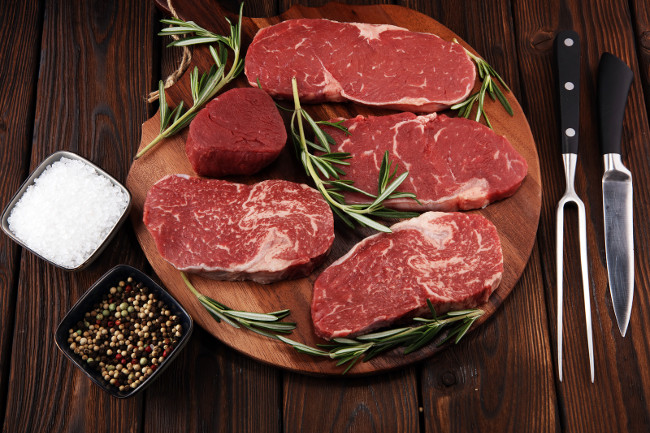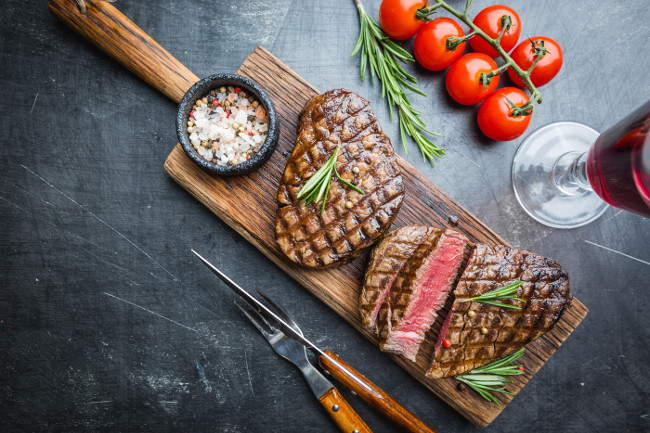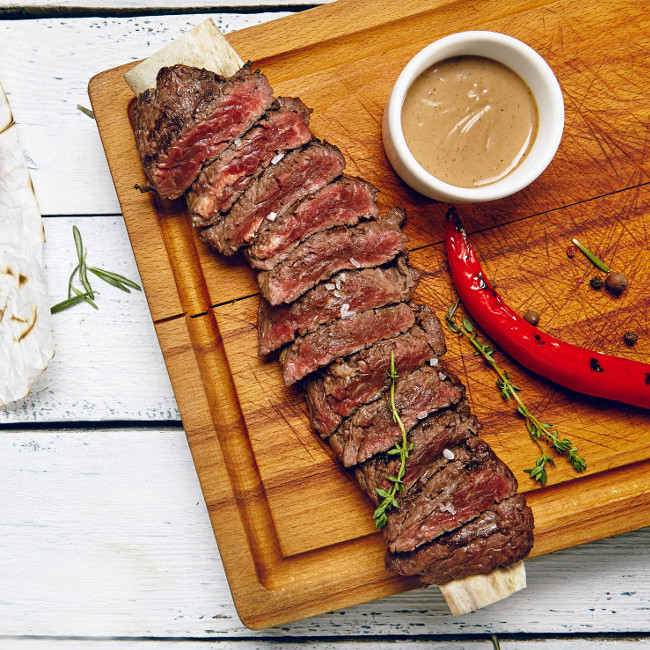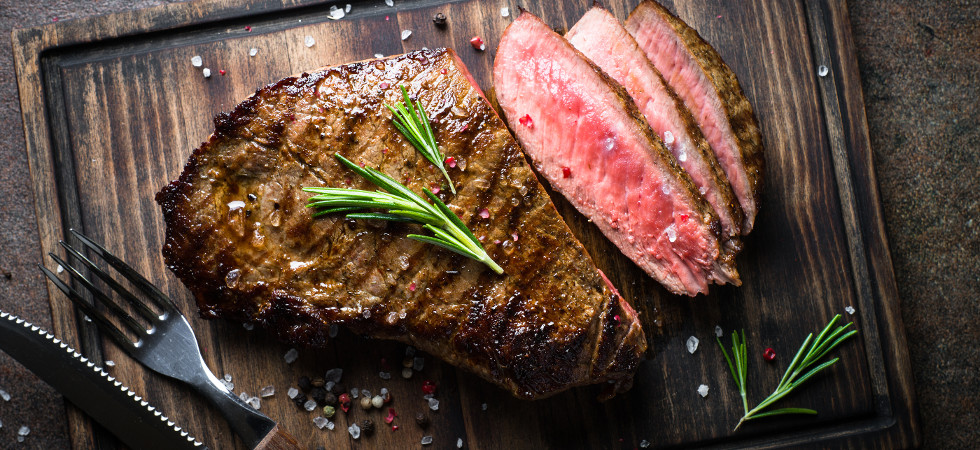If we had to survive on just one meal it would be a perfectly prepared steak, served with chunky, skin-on fries and a rich and powerful peppercorn sauce. Perfect. Considering you’ve found your way here, we’re assuming you’re of a similar suit?
Below, The Bluebeards Revenge have rounded up all of their steak-searing advice to give you the best chance of cooking a Michelin Star meal.
The different types of steak
There is a great amount of variety when it comes to choosing a steak. Ultimately, the cut you choose to feast upon is down to personal preference. Just remember that different cuts will deliver different levels of tenderness and flavour. Some cuts will also hit you harder in the money sacks, but personally we think they’re worth every penny.
Rump: Also known as round steak, rump is a less costly cut of beef that is taken from the hindquarters of the cow. Make sure to spend some time tenderizing or marinating this cut before cooking.
Fillet: Fillet steak is renowned for being the tenderest cut of beef. The meat is super lean and very fine-grained in texture. As one of the most expensive cuts, it’s widely believed that this steak is best served rare.
T-bone: The name says it all; this cut features a t-shaped bone with succulent meat on both sides. You really do get the best of both worlds here: tenderloin (also known as fillet) on one side and juicy strip steak on the other. Maybe you could share it?

Bavette: This fan-shaped cut, also known as the flank, is an extension of the T-bone and is your best friend when it comes to barbeque season. It’s a cheaper cut and is best served medium.
Sirloin: A classic sirloin steak is considered to be a prime piece of meat – think of it as a fillet steak with a little more marbling. The extra fat provides a punch of added flavour and is best served medium-rare.
Rib-eye: If you’re hunting for a super beefy steak that drips with juice then look no further than rib-eye. There’s a fair amount of fat marbling through this cut which helps to pack in extra flavour.
The best way to season a steak
You have a few different options when it comes to seasoning your steak; you can take the purist approach and apply nothing more than a light sprinkle of salt and pepper, or you can marinate that bad boy for a more intense flavour. Either way, we have some tips, of course.
You might have heard through the rumour mill that seasoning your steak with salt before cooking removes vital moisture from your meat. In reality, this couldn’t be further from the truth. Instead, seasoning your steak a few hours before searing will help it to absorb everything evenly. This ultimately provides a more balanced taste.
To prepare a traditional peppered steak, start by dusting a plate with lots of cracked black pepper and sea salt. Next, press your steak into the seasoning mix and flip it to coat the other side evenly. This method is far more effective than cracking the pepper and salt onto the meat because the pressing helps to penetrate further into the flesh.
Looking for something a little punchier? A marinade will help to tenderise your steak further (especially the cheaper cuts) and will add a whole new tang to your plate. For a sweeter glaze, try marinating your beef in either balsamic vinegar or honey and mustard. For an aromatic Asian feel, try a miso or teriyaki marinade.

The best way to sear a steak
Searing your steak is incredibly important and often overlooked. The whole point of searing your steak is to give it a flavoursome, caramelised crust, while making sure it stands out when you inevitably upload it to Instagram.
The best way to build a perfectly even crust is to cook each side of your steak in one minute intervals. So, if you wanted the perfect medium-rare sirloin you’d be looking at cooking the steak for four minutes total; flipping it every minute for an even sear.
How to tell the difference between blue to well-done steaks
Personally we like our steak medium-rare, but we understand that everyone’s different. The margins between some of these are pretty fine, so make sure you take notes on the nuances.
Blue: Fresh from the field! It should be so dark in colour that it’s basically purple. Just make sure it’s warm enough to enjoy.
Rare: It should’ve stopped mooing by this point. It should also be dark red in colour, with a good flow of juice.
Medium-rare: Pink in colour with some juice, but not too much.
Medium: Most people would accept that the steak is ‘cooked’ at this point. Anything beyond this is down to preference. It should be pale pink in the centre with hardly any juice.
Well-done: There should still be a tiny trace of pink through the middle. It shouldn’t be so dry that it could be confused for a leather boot.
Cooking times for steaks
We’ve covered the cooking times for two of our favourite steaks below, but it’s crucial to remember to factor in the size and weight of your steak before setting a final cooking time. If you can’t judge it accurately, just ask the butcher when you buy your meat – a good one should be able to help you out.
3.5cm thick fillet steak
– Blue: 1.5 minutes on each side
– Rare: 2.25 minutes on each side
– Medium-rare: 3.25 minutes on each side
– Medium: 4.5 minutes on each side
– Well-done: 5.5 minutes on each side
2cm thick sirloin steak
– Blue: 1 minute on each side
– Rare: 1.5 minutes on each side
– Medium-rare: 2 minutes on each side
– Medium: 2.25 minutes on each side
– Well-done: 4.5 minutes on each side

How to rest a steak
Once you’ve nailed the cooking part, the next step is to properly rest your meat. The importance of resting your steak is in the science. Don’t worry, it’s not overly technical – no need to grab your lab coat. Basically, the fibres of the meat will reabsorb any juices, resulting in a tender steak that’s super succulent. In order for this to work, your steak should be rested (at room temperature) for at least five minutes.
How to cook the perfect steak
Right, that’s all the important bits covered. Now let’s put them all together in one simple recipe.
A few hours before cooking, prepare your chosen marinade or sprinkle cracked black pepper and sea salt onto a plate. Marinate your steak or press it into your seasonings.
Get a heavy-based frying pan piping hot before drizzling in a little oil.
Add your chosen steak and a knob of butter.
Sear your steak evenly on each side, turning it every minute until you reach the allotted cooking time.
Remove the steak from the pan and leave it to rest at room temperature for five minutes.
Serve the steak whole (or carved into slices) with a fistful of chunky, skin-on chips, a little salad and a peppercorn sauce.






















